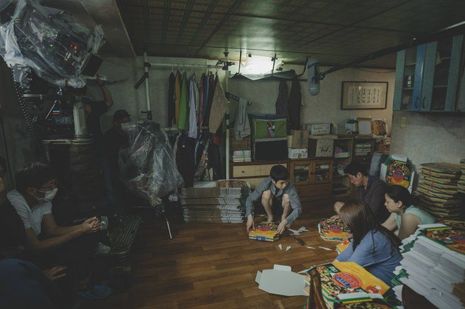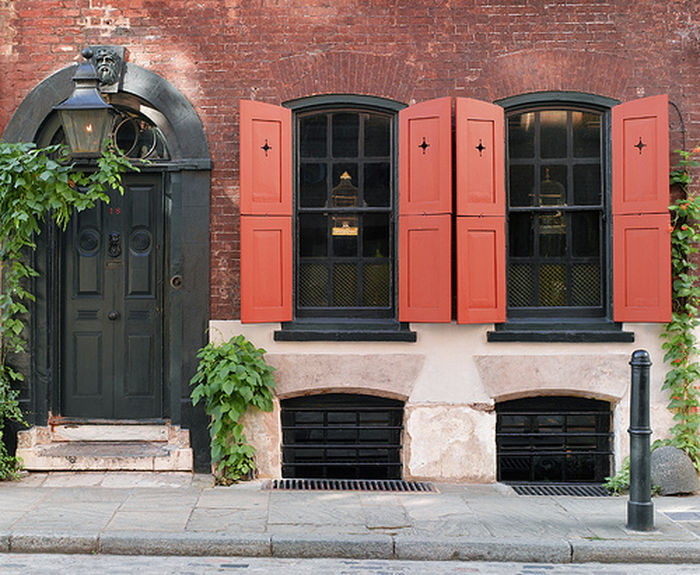And the Oscar goes to: Parasite’s architecture
Andreas Charidemou praises the film’s nuanced use of architecture to evoke social oppression and the class divide.
Architecture is the real star of the film Parasite. Arguably, if you removed all the actors from the film’s shots, Bong’s message would still be successfully conveyed by the architecture. The film is a satire of inequality, using a dark tale to portray the stark class divide that exists in South Korea, and to some extent in all western liberal democracies. While all of Bong’s movies are dark comic sendups of today's late capitalism (for example, Okja and Snowpiercer), Parasite is different. The message of the film is subtler, closer to the audience’s reality. The struggles of the characters don’t take place in a post-apocalyptic train or in an evil corporation, but in everyday domestic settings.

The film starts with shots of the Kim household, a dark, dirty semi-basement. Their poverty is comically evident: drunken wanderers urinate by their window, and when a fumigator sprays their house, the father joyously boasts “We’ll get free extermination!” This kind of a home is not unrealistic in South Korea. These spaces were bunkers during the war, but began to be used as residential spaces after the 1980s housing shortage. In an interview, Bong explained that this dwelling does more than reflect the Kim’s place in society. “It really reflects the psyche of the Kim family; you’re still half over ground, so there’s this hope and this sense that you still have access to sunlight and you haven’t completely fallen to the basement yet. It’s this weird mixture of hope and this fear that you can fall even lower. I think that really corresponds to how the protagonists feel.”
Meanwhile, the Park house smacks of the vain sophistication of its owners. Its modern minimalism, with its clean lines and silhouettes, large spaces covered with wood and glass, expensive artwork on the walls, is exactly what critic Kate Wagner described as ‘McModern’. The kind of architecture is favoured by the ‘new money’ types, perceived by its owners as culturally significant and revered by the educated elite and their glossy magazines. Bong explains that the mother “wants to show she is not like the rich old-timers—she is a new, young rich person with very sophisticated taste.” But the house does much more than that. The reference to the fictional architect of the house, Namgoong Hyeonja, is a signal to the audience to pay close attention to the building’s design. Ultimately, the dark plot twist is made even more sinister by the fact that it happens in a seemingly cosy and comfortable domestic environment. This 21st-century haunted house ultimately enables a fully-fledged attack on the viewers’ senses.
The true artistic triumph of the film’s architecture lies in the masterful contrast established between the two households. The camera enters the Kim family space in an intrusive manner, descending from above and adding to the claustrophobic atmosphere of the house. To get to the Park house, one needs to ascend; the roads leading to it are cleverly framed, always filmed from the bottom upwards. The house itself is set upon a hill, separated from the world that the Kims live in. The rain scene illustrates this graphically. For the Park family, the rain is entertainment, just another comforting spectacle from their elegant parlor: “Rain falling on the lawn, as we sip our whiskey” Dong- ik says. In the Ahyeon-dong neighbourhood, the rain is almost apocalyptic, completely annihilating people's homes and forcing them to evacuate. The privilege of wealth could not be more carefully portrayed.
The movie ends with Ki–woo setting a plan in motion to free his father. He envisions becoming successful, buying the house, meeting his father in the Park residence's idyllic garden... But the vision is revealed to be nothing more than a dream. The house represents a level of privilege that is, for many, unattainable; a house, a life that people like Ki–woo can only dream of.
 News / Clare Hall spent over £500k opposing busway 24 December 2025
News / Clare Hall spent over £500k opposing busway 24 December 2025 Comment / The ‘class’ of Cambridge24 December 2025
Comment / The ‘class’ of Cambridge24 December 2025 News / Caius mourns its tree-mendous loss23 December 2025
News / Caius mourns its tree-mendous loss23 December 2025 Comment / League tables do more harm than good26 December 2025
Comment / League tables do more harm than good26 December 2025 News / Girton JCR publishes open letter expressing solidarity with Palestine25 December 2025
News / Girton JCR publishes open letter expressing solidarity with Palestine25 December 2025









